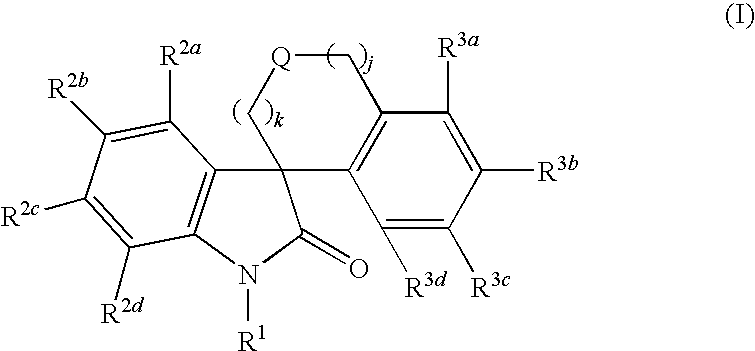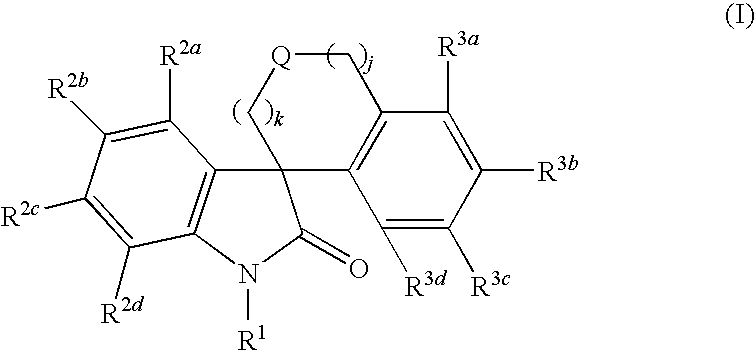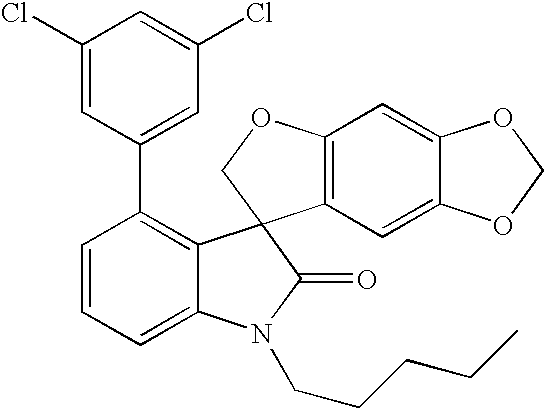Use of spiro-oxindole compounds as therapeutic agents
a technology of spiro-oxindole and compound, which is applied in the direction of drug composition, biocide, metabolic disorder, etc., can solve the problems of major pathophysiological conditions, major changes, and insufficient potency and therapeutic index of these blockers, so as to increase the potency of existing or future drug therapy and reduce adverse events
- Summary
- Abstract
- Description
- Claims
- Application Information
AI Technical Summary
Benefits of technology
Problems solved by technology
Method used
Image
Examples
preparation 1
Synthesis of 4-bromo-3-(6-hydroxy-1,3-benzodioxol-5-yl)-3-(hydroxymethyl)-1-pentyl-1,3-dihydro-2H-indol-2-one
A. Synthesis of 4-bromo-1-pentyl-1H-indole
[1816]To a mixture of sodium hydride (2.54 g, 66.3 mmol, 60% dispersion in mineral oil) in anhydrous N,N-dimethylformamide (50.0 mL) was added 4-bromoindole (10.0 g, 51.0 mmol) at 0° C. The reaction mixture was stirred for 0.5 h followed by the addition of 1-bromopentane (9.25 g, 61.2 mmol) at 0° C. The reaction mixture was stirred at ambient temperature for 6 h and quenched with brine solution (20.0 mL). The reaction mixture was diluted with water (100 mL) and extracted with ether (3×200 mL). The combined organic layers was washed with brine (100 mL), dried over anhydrous sodium sulfate and filtered. The filtrate was concentrated in vacuo to dryness. The residue was subjected to column chromatography eluting with hexane (100%) to give the title compound (13.3 g, 98%) as a yellow oil: 1H NMR (300 MHz, CDCl3) δ 7.30-7.27 (m, 2H), 7.14 ...
preparation 2
Synthesis of 1-(2-cyclopropylethyl)-3-(6-hydroxy-1,3-benzodioxol-5-yl)-3-(hydroxymethyl)-1,3-dihydro-2H-indol-2-one
A. Synthesis of 1-(2-cyclopropylethyl)-1H-indole-2,3-dione
[1821]To a suspension of sodium hydride (1.61 g, 41.9 mmol, 60% dispersion in mineral oil) in anhydrous N,N-dimethylformamide (25.0 mL) was added isatin (6.17 g, 41.9 mmol) at 0° C. The reaction mixture was stirred for 0.5 h followed by the addition of (2-bromoethyl)cyclopropane (Maercker, A., et al, Justus Liebigs Ann. Chem. (1972), 759:132-157) (9.25 g, 61.2 mmol). The resulting mixture was stirred at ambient temperature for 16 h and quenched with water (50.0 mL). The mixture was extracted with ethyl acetate (3×100 mL). The combined organic layers was washed with water (3×50.0 mL), dried over anhydrous sodium sulfate and filtered. The filtrate was concentrated in vacuo to dryness to yield the title compound (6.50 g, 90%) as a viscous gum: 1H NMR (300 MHz, CDCl3) δ 7.57-7.51 (m, 2H), 7.05 (t, 1H), 6.88 (d, 1H), ...
preparation 3
Synthesis of ethyl [3-(6-hydroxy-1,3-benzodioxol-5-yl)-3-(hydroxymethyl)-2-oxo-2,3-dihydro-1H-indol-1-yl]acetate
A. Synthesis of ethyl (2,3-dioxo-2,3-dihydro-1H-indol-1-yl)acetate
[1825]Following the procedure as described in PREPARATION 2A, and making non-critical variations to replace (2-bromoethyl)cyclopropane with ethyl bromoacetate, the title compound was obtained (79%) as a light yellow powder: 1H NMR (300 MHz, CDCl3) δ 7.64-7.54 (m, 2H), 7.16-7.11 (m, 1H), 6.77 (d, 1H), 4.47 (s, 2H), 4.22 (q, 2H), 1.26 (t, 3H); MS (ES+) m / z 256.2 (M+23).
B. Synthesis of ethyl [3-hydroxy-3-(6-hydroxy-1,3-benzodioxol-5-yl)-2-oxo-2,3-dihydro-1H-indol-1-yl]acetate
[1826]Following the procedure as described in PREPARATION 2B, and making non-critical variations to replace 1-(2-cyclopropylethyl)-1H-indole-2,3-dione with ethyl (2,3-dioxo-2,3-dihydro-1H-indol-1-yl)acetate, the title compound was obtained (95%): 1H NMR (300 MHz, DMSO-d6) δ 9.08 (s, 1H), 7.21-7.13 (m, 2H), 6.93-6.86 (m, 3H), 6.57 (s, 1H), 6...
PUM
 Login to View More
Login to View More Abstract
Description
Claims
Application Information
 Login to View More
Login to View More - R&D
- Intellectual Property
- Life Sciences
- Materials
- Tech Scout
- Unparalleled Data Quality
- Higher Quality Content
- 60% Fewer Hallucinations
Browse by: Latest US Patents, China's latest patents, Technical Efficacy Thesaurus, Application Domain, Technology Topic, Popular Technical Reports.
© 2025 PatSnap. All rights reserved.Legal|Privacy policy|Modern Slavery Act Transparency Statement|Sitemap|About US| Contact US: help@patsnap.com



